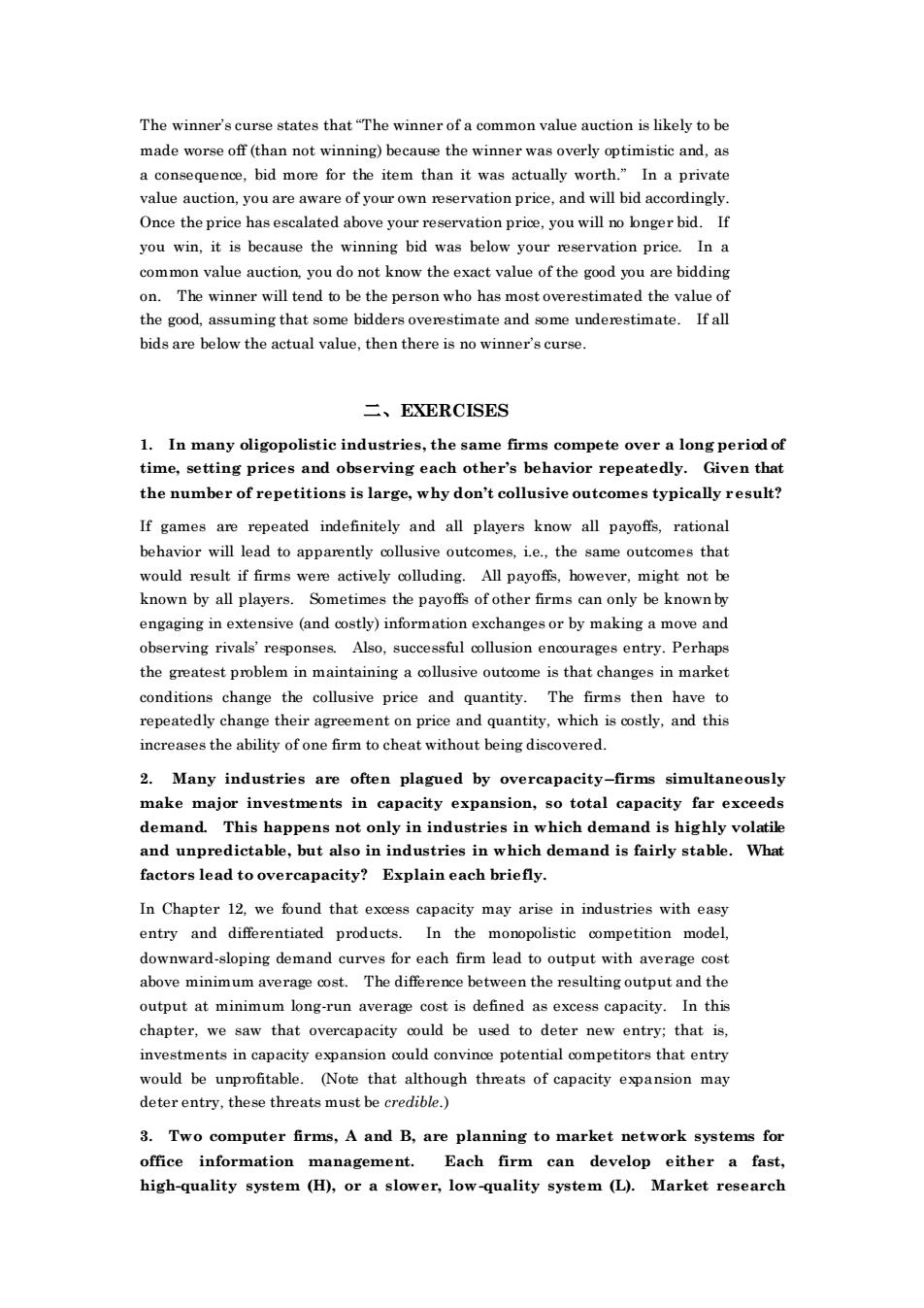正在加载图片...

The winner's curse states that"The winner of a common value auction is likely to be madeworseof(than notwinning)because the winner was overly optimistic and,as a consequen,bid more for the item than it was actually worth In a private value auction,you are aware of your own reservation price,and will bid accordingly Once the price has escalated above your reservation price.you will no bnger bid.If you win,it is because the winning bid was below your reservation price.In a common value auction,you do not know the exact value of the good you are bidding 0n. The winne end to be valu the good,assuming that some bidders overestimate and some underestimate.If al bids are below the actual value,then there is no winner's curse. 二、EXERCISES 1.In many oligopolistic industries,the same firms compete over a long period of time,setting prices and observing each other's behavior repeatedly.Given that the number of repetitions is large,why don't collusive outcomes typically result? If gamesar repeated indefinitely and all players know all payoffs rational behavior will lead to apparently coll ve outcomes,1.e. the same outcomes tha would result if firms were actively colluding.All payoffs.bowever.might not be known by all players.Sometimes the payoffs of other firms can only be known by engaging in extensive (and costly)information exchanges or by making a move and observing rivals'responses.Also.successful collusion encourages entry.Perhaps the greates poblem in maintaining is that change in marke conditions change the collusive price and quantity The firms then have to repeatedly change their agreement on price and quantity,which is costly.and this increases the ability of one firm to cheat without being discovered. 2.Many industries are often plagued by overcapacity-firms simultaneously make maior investments in capacity exp ansion,so total cap acity far exceeds demand.This hap t only in industries s in which de nd is highly volatile and unpredictable, but also in industries in whie h demand i fairly sta Wha factors lead to overcapacity?Explain each briefly. In Chapter 12.we found that excess capacity may arise in industries with easy entry and differentiated products.In the monopolistic competition model, downward-sloping demand curvesfor eachfirm lead to output with average cost above minim The between the res sulting outpu output at minimum long-run average cost is defined as excess capacity. n this chapter,we saw that overcapacity oould be used to deter new entry;that is, investments in capacity expansion could convince potential competitors that entry would be unprofitable.(Note that although threats of capacity expansion may deter entry.these threats must be credible. 3.Two computer firms,A and B.are planning to market network systems for office information management. Each can dev lop either a fast high-quality system (H),or a slower,low-quality system (L).Market research The winner’s curse states that “The winner of a common value auction is likely to be made worse off (than not winning) because the winner was overly optimistic and, as a consequence, bid more for the item than it was actually worth.” In a private value auction, you are aware of your own reservation price, and will bid accordingly. Once the price has escalated above your reservation price, you will no longer bid. If you win, it is because the winning bid was below your reservation price. In a common value auction, you do not know the exact value of the good you are bidding on. The winner will tend to be the person who has most overestimated the value of the good, assuming that some bidders overestimate and some underestimate. If all bids are below the actual value, then there is no winner’s curse. 二、EXERCISES 1. In many oligopolistic industries, the same firms compete over a long period of time, setting prices and observing each other’s behavior repeatedly. Given that the number of repetitions is large, why don’t collusive outcomes typically result? If games are repeated indefinitely and all players know all payoffs, rational behavior will lead to apparently collusive outcomes, i.e., the same outcomes that would result if firms were actively colluding. All payoffs, however, might not be known by all players. Sometimes the payoffs of other firms can only be known by engaging in extensive (and costly) information exchanges or by making a move and observing rivals’ responses. Also, successful collusion encourages entry. Perhaps the greatest problem in maintaining a collusive outcome is that changes in market conditions change the collusive price and quantity. The firms then have to repeatedly change their agreement on price and quantity, which is costly, and this increases the ability of one firm to cheat without being discovered. 2. Many industries are often plagued by overcapacity-firms simultaneously make major investments in capacity expansion, so total capacity far exceeds demand. This happens not only in industries in which demand is highly volatile and unpredictable, but also in industries in which demand is fairly stable. What factors lead to overcapacity? Explain each briefly. In Chapter 12, we found that excess capacity may arise in industries with easy entry and differentiated products. In the monopolistic competition model, downward-sloping demand curves for each firm lead to output with average cost above minimum average cost. The difference between the resulting output and the output at minimum long-run average cost is defined as excess capacity. In this chapter, we saw that overcapacity could be used to deter new entry; that is, investments in capacity expansion could convince potential competitors that entry would be unprofitable. (Note that although threats of capacity expansion may deter entry, these threats must be credible.) 3. Two computer firms, A and B, are planning to market network systems for office information management. Each firm can develop either a fast, high-quality system (H), or a slower, low-quality system (L). Market research